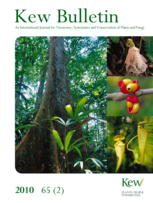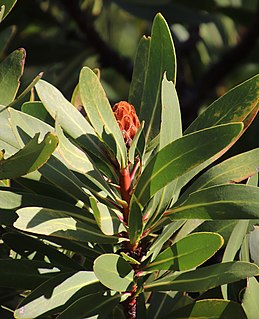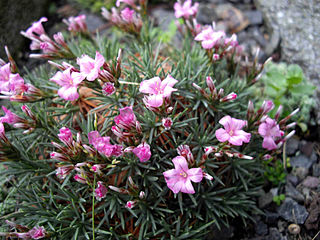
Royal Botanic Gardens, Kew, is a non-departmental public body in the United Kingdom sponsored by the Department for Environment, Food and Rural Affairs. An internationally important botanical research and education institution, it employs 1,100 staff. Its board of trustees is chaired by Dame Amelia Fawcett.

Hepatica is a genus of herbaceous perennials in the buttercup family, native to central and northern Europe, Asia and eastern North America. Some botanists include Hepatica within a wider interpretation of Anemone.

Selenicereus, sometimes known as moonlight cactus, is a genus of epiphytic, lithophytic, and terrestrial cacti, found in Mexico, Central America, the Caribbean and northern South America. The term night-blooming cereus is also sometimes used, but this is also used for many night-blooming cacti, including Epiphyllum and Peniocereus. In 2017, the genus Hylocereus was brought into synonymy with Selenicereus. A number of species of Selenicereus produce fruit that is eaten. The fruit, known as pitaya or pitahaya in Spanish or as dragon fruit, may be collected from the wild or the plants may be cultivated.
William Botting Hemsley was an English botanist and 1909 Victoria Medal of Honour recipient.

Otto Wilhelm Sonder was a German botanist and pharmacist.

Ulmus castaneifoliaHemsley, the chestnut-leafed elm or multinerved elm, is a small deciduous tree found across much of China in broadleaved forests at elevations of 500–1,600 metres (1,600–5,200 ft).

Kew Gardens is a botanic garden in southwest London that houses the "largest and most diverse botanical and mycological collections in the world". Founded in 1840, from the exotic garden at Kew Park, its living collections includes some of the 27,000 taxa curated by Royal Botanic Gardens, Kew, while the herbarium, one of the largest in the world, has over 8.5 million preserved plant and fungal specimens. The library contains more than 750,000 volumes, and the illustrations collection contains more than 175,000 prints and drawings of plants. It is one of London's top tourist attractions and is a World Heritage Site.

Lumnitzera is an Indo-West Pacific mangrove genus in the family Combretaceae. An English common name is black mangrove. Lumnitzera, named after the German botanist, Stephan Lumnitzer (1750-1806), occurs in mangroves from East Africa to the Western Pacific, and northern Australia.
John Dransfield is an honorary research fellow and former head of palm research at the Royal Botanic Gardens, Kew, United Kingdom, as well as being an authority on the phylogenetic classification of palms.

The Kew Bulletin is a quarterly peer-reviewed scientific journal on plant and fungal taxonomy and conservation published by Springer Science+Business Media on behalf of the Royal Botanic Gardens, Kew. Articles on palynology, cytology, anatomy, phytogeography, and phytochemistry that relate to taxonomy are also included.
The World Checklist of Selected Plant Families is an "international collaborative programme that provides the latest peer reviewed and published opinions on the accepted scientific names and synonyms of selected plant families." Maintained by the Royal Botanic Gardens, Kew, it is available online, allowing searches for the names of families, genera and species, as well as the ability to create checklists.

Symphyotrichum subulatum, commonly known as eastern annual saltmarsh aster or, in Britain and Ireland where it is naturalized, annual saltmarsh aster, is an annual plant in the family Asteraceae native to the eastern United States and the Gulf Coast to Texas. The species grows primarily in coastal salt marshes, although in the Ozarks it occurs as a non-marine weedy variety.

Acantholimon libanoticum(Lebanese prickly thrift, غملول لبناني) is a plant in the family Plumbaginaceae first described by Pierre Edmond Boissier. It is native to Western Asia from Turkey to Syria and Lebanon.
Yvonne Chuan Fang Su is a Hongkonger evolutionary biologist who is notable for her co-discovery of Pseuduvaria bruneiensis and Pseuduvaria borneensis. Her doctoral work at the University of Hong Kong focused on the phylogeny of the flowering plant genus Pseuduvaria. Her work as a faculty member at Duke–NUS Medical School focuses on the evolution of viruses.

Protea rubropilosa, also known as the Transvaal sugarbush, escarpment sugarbush or Transvaal mountain sugarbush, is a flowering tree, that belongs to the genus Protea in the family Proteaceae. The plant only occurs in South Africa.

Protea burchellii, also known as Burchell's sugarbush, is a flowering shrub in the genus Protea, which is endemic to the southwestern Cape Region of South Africa.
Zanthoxyloideae is a subfamily of the family Rutaceae.

Solanum heterodoxum, the melonleaf nightshade, is a species of flowering plant in the family Solanaceae. It is native to Mexico and the US state of New Mexico, and has been introduced to Bulgaria. Solanum heterodoxum var. setigeroides is now considered to be a full species, Solanum setigeroides, native to more northerly areas of the United States than S. heterodoxum.

Acantholimon acerosum is a species of plant in the Plumbaginaceae family that is native from Turkey to Northwest Iran. The species are evergreen and sprout flowers June. Acantholimon acerosum grows in light well drained soil that are gritty and limey.

Acantholimon ulicinum, also known as the prickly thief, is a species of broadleaf evergreen plants in the family Plumbaginaceae. Acantholimon ulicinum is around 10 cm (4 in) tall and has a spread of 30 cm (1 ft). The species is endemic to the eastern Mediterranean region where it grows in dry soil. From June to July is when Acantholimon ulicinum blooms, with pale pink flowers. It has crowded, rigid, hard-textured, spiny-tipped, linear and needle-like leaves, and five-petaled pink flowers in short-stalked inflorescences.














